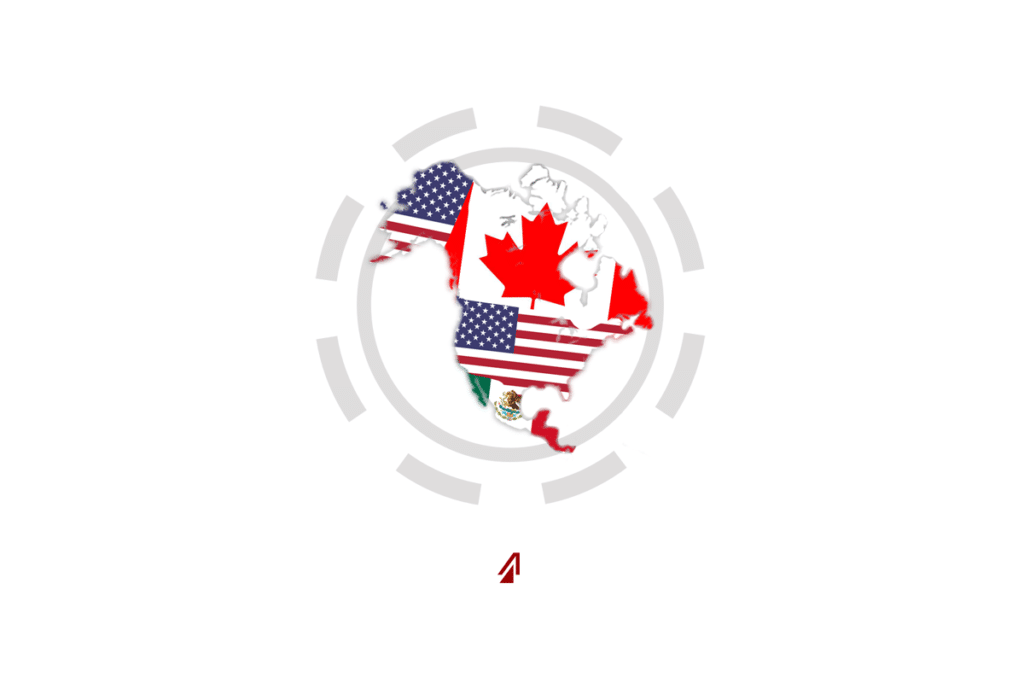The wait is over. The aging 1994 NAFTA trade deal is soon to be replaced with the new USMCA. The United States-Mexico-Canada Agreement took over 14 months to negotiate and was finally agreed upon late Sunday, September 30. President Trump is expected to sign the agreement in late November, with Congress to vote on it at the beginning of next year. “USMCA is a great deal for all three countries, solves the many deficiencies and mistakes in NAFTA, greatly opens markets to our farmers and manufacturers, reduces trade barriers to the U.S. and will bring all three Great Nations together in competition with the rest of the world,” says President Trump. See what to expect in the coming months for trade on the North American continent.
Automotive
USMCA focuses on many trade facets, but one of the largest impacted is the North American automotive industry. With the new deal, approximately 75% of all car parts used by automotive companies in the US, Mexico, and Canada will need to be made here. This is up from the 62.5% standard held by NAFTA. Also, 40-45% of the parts used need to be sourced from factories that pay production workers at least $16 per hour. Current US Trade Representative, Robert Lighthizer, says it is an effort to return auto-production to the US, as the $16 per hour wage is more than three times what Mexico’s current auto-worker’s salary is and short of the average $22 per hour US auto workers currently earn. The Ford Motor Company announced that they were “very encouraged by today’s announcement, and we applaud all three governments for working together to achieve free and fair trade in a strong regional agreement… The benefits of scale and global reach will help to drive volume and support manufacturing jobs.” Detractors to the new deal worry that the cost of manufacturing will drive production outside of the US to Asia and European manufacturers.
The US automotive market was expanded to allow more imports of Canadian and Mexican produced cars and light trucks. Canada and Mexico were also exempted from future US auto tariffs for an additional 2.6 million imported vehicles. That is roughly the amount the US imported last year from Mexico and nearly double the amount imported from Canada.
Dairy and Wine
The old NAFTA deal severely limited the US dairy exports to Canada, but the new USMCA has opened the Canadian markets. The USMCA will give US dairy farmers up to 3.6% of the Canadian dairy market and also cease Canadian low price fixing on milk. The US will increase exports of dairy, eggs, and poultry to Canada, and Canada will increase their exports of dairy, peanuts, and peanut products to the US. The US and Mexico have also increased their trade and marketing allowances with each other – specifically in regards to cheese.
Canada has also relaxed wine tariffs and removed restrictions on British Columbian supermarkets to only hold B.C. wines. These supermarkets will now allow and stock US wines on their shelves. The move is expected to greatly benefit Northern California vineyards.
Technology and E-Commerce
North American technology and e-commerce businesses also received attention in the new deal. The US set up protection for several intellectual property and digital services. Some of these include harsher penalties for digital piracy on electronically distributed media and software. Other protections include those on intellectual property for biotech and pharmaceutical patents. In the US, patent monopolies for drugs and biotech are protected for 12 years. The new USMCA deal allows for 10 year protection – up from the 5 year protection offered by NAFTA. This change is expected to drive down medication costs in the US, while USMCA detractors fear higher prices for drugs in Canada.
In e-commerce, Canadian and Mexican shoppers now benefit from raised duty-free limits on online purchases. Mexico raised their duty-free amount from $50 to $100 limits on e-purchases, and Canada followed with $20 limits reaching a new limit of $115. This will make products cheaper for Canadian and Mexican shoppers, allowing them to purchase more, and also allow electronic marketplaces, like Amazon, greater expansion to these regions.
Finance
The USMCA allows the US more access to Mexican and Canadian financial markets and also has provisions to deter currency manipulations from foreign actors. North American currencies remain stable within the three nations, but the deal strives to signal to other players like China to play fairly.
Regulation/Dispute
The USMCA was not made without contention. One of the hot topics was determining when to end the deal itself. The US pushed for a “sunset clause” to terminate the trade deal within five years without unanimous approval to keep it. Canada, however, wanted to keep the deal in place indefinitely. Canada’s US ambassador David MacNaughton said, “None of the things we put on the table was as challenging as [an] American sunset clause that said after five years this thing goes away unless all three parties agree.” The representatives agreed to allow the three nations 16 years before cancelling USMCA. The nations are set to review the deal every six years to discuss termination or changes.
Another concession for the US is the continuation of the Chapter 19 provision. This allows outside parties to sue countries on the basis of tariffs and other economic impositions. The suit would take place before an international panel of trade representatives from all three countries to arbitrate and impose reparations.
Chapter 20 provisions are also preserved from the old NAFTA deal. Chapter 20 is a dispute path providing more national sovereignty than Chapter 19 provides. First, under Chapter 20, countries would directly work with one another first – government to government. Next, if the governments could not resolve the issue, the matter would be brought to meet NAFTA representatives, made of the nations’ trade ministers. Lastly, if no other resolution is available, the matter would be brought to a five member arbitration panel.
An additional change, Canada was removed from Chapter 11 provisions. Chapter 11 provides for protection for investors from North American nations. USMCA outlines specific protections for oil, gas, telecommunications, and infrastructure investment between the US and Mexico.
While some call the deal NAFTA 2.0 or feel it is the same deal in different packaging, it is clear, that progress is being made on the North American trade front. The Bertelsmann Foundation, in a 2018 study, found that less than 1 in 3 Americans approved of the 1994 NAFTA deal, and the Trump administration is holding to its promise to remove NAFTA and replace it. The USMCA is a definite effort to limit restrictions on North American trade items, protect North American workers and their intellectual property, and send a message to the world that working with us is in their best interest.
Update
Mexico was the first nation to officially ratify this agreement. In June 2019, the Mexican Senate approved the deal 114 for, 4 against. Mexican President Andres Manuel Lopez Obrador said “We celebrate the approval in the Senate of the [USMCA], to maintain our economic and commercial relations with the United States and Canada … It means foreign investment in Mexico, it means jobs in Mexico, it means guaranteeing trade of the merchandise that we produce in the United States.”
The U.S. Congress ratified the deal and it was signed into law January 29th, 2020. President Trump remarked, For the first time in American history, we have replaced a disastrous trade deal that rewarded outsourcing with a truly fair and reciprocal trade deal that will keep jobs, wealth, and growth right here in America… It’s really a trade partnership, if you look at it that way. And it’s a day of great celebration in all three countries.
Canada remains the only nation to ratify the deal at the time of this writing.



